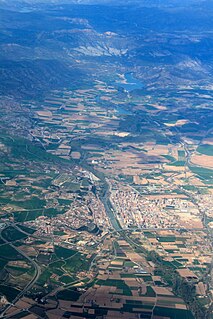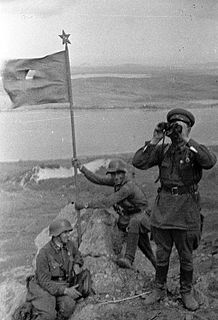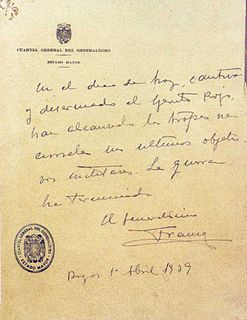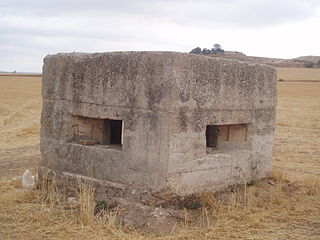 W
WThe 1936–1939 Arab revolt in Palestine, later came to be known as The Great Revolt or The Great Palestinian Revolt, was a nationalist uprising by Palestinian Arabs in Mandatory Palestine against the British administration of the Palestine Mandate, demanding Arab independence and the end of the policy of open-ended Jewish immigration and land purchases with the stated goal of establishing a "Jewish National Home". The dissent was directly influenced by the Qassamite rebellion, following the killing of Sheikh Izz ad-Din al-Qassam in 1935, as well as the declaration by Hajj Amin al-Husseini of 16 May 1936 as 'Palestine Day' and calling for a General Strike. The revolt was branded by many in the Jewish Yishuv as "immoral and terroristic", often comparing it to fascism and Nazism. Ben Gurion, however, described Arab causes as fear of growing Jewish economic power, opposition to mass Jewish immigration and fear of the English identification with Zionism.
 W
WThe Balaguer Offensive was an offensive carried out by the Spanish Republican Army around Balaguer during the Spanish Civil War. The offensive consisted in a series of counterattacks in the spring and summer of 1938 after the disastrous Aragon Offensive. The offensive was a failure for the Spanish Republic and many lives and military material were wasted.
 W
WThe Battle of Bielsa pocket took place between 14 April and 15 June 1938, during the Spanish Civil War. After the fall of the Aragon front, a Republican division, in April 1938, was surrounded by the Nationalists in the Cinca River Valley. The division, despite being heavily outnumbered, managed to hold until 6 July and then crossed the French frontier.
 W
WThe Bombing of Barcelona was a series of Fascist Italian and Nazi German airstrikes supporting the Franco-led Nationalist rebel army, which took place from 16th through 18th March 1938, during the Spanish Civil War. Up to 1,300 people were killed and at least 2,000 wounded. It is considered the first carpet bombing from air in history.
 W
WSS Cantabria was a Spanish cargo ship which was sunk in a military action of the Spanish Civil War, off the coast of Norfolk 12 miles ENE of Cromer on 2 November 1938. The ship was shelled by the Spanish Nationalist auxiliary cruiser Nadir, which was part of General Franco's navy.
 W
WThe Canton Operation was part of a campaign by Japan during the Second Sino-Japanese War to blockade China to prevent it from communicating with the outside world and importing needed arms and materials. Control of Guangzhou (Canton) and the Pearl River Delta would provide a base to make the blockade of Guangdong province more effective by seizing southern China's major port and isolate the British port of British Hong Kong.
 W
WThe Battle of Cape Palos, also known as the Second Battle of Cape Palos, was the biggest naval battle of the Spanish Civil War, fought on the night of March 5–6, 1938, east of Cape Palos near Cartagena, Spain.
 W
WThe Catalonia Offensive was part of the Spanish Civil War. The Nationalist Army started the offensive on 23 December 1938 and rapidly conquered Republican-held Catalonia with Barcelona. Barcelona was captured on 26 January 1939. The Republican government headed for the French border. Thousands of people fleeing the Nationalists also crossed the frontier in the following month, to be placed in internment camps. Franco closed the border with France by 10 February 1939.
 W
WThe bombing of Chongqing, from 18 February 1938 to 23 August 1943, was part of a terror bombing operation conducted by the Imperial Japanese Army Air Service and Imperial Japanese Navy Air Service on the Chinese provisional capital of Chongqing and other targets in Sichuan, authorized by the Imperial General Headquarters.
 W
WThe Dersim rebellion was an Alevi-Zaza uprising against the Turkish government in the Dersim region of eastern Turkey, which includes parts of Tunceli Province, Elazığ Province, and Bingöl Province. The rebellion was led by Seyid Riza, an Alevi-Zaza chieftain of the Yukarı Abbas Uşağı tribe. As a result of the Turkish Armed Forces campaign in 1937 and 1938 against the rebellion and its massacres of civilians, thousands of Alevi Zazas died and many others were internally displaced.
 W
WAmanullah loyalism refers to several historical movements in the Kingdom of Afghanistan to restore Amanullah Khan as king of Afghanistan after he was deposed in January 1929 during the Afghan Civil War. Loyalists were sometimes referred to as Amanite. Loyalists tried to achieve this in various ways, including armed rebellions, political parties, colluding with foreign powers and assassinations. These movements were unsuccessful, and Amanullah died in exile in 1960 in Zürich, Switzerland without ever regaining control, other than a brief period of control in southern Afghanistan in the 1929 Afghan Civil War.
 W
WThe Bombing of Granollers took place during the Spanish Civil War in 1938. On 31 May 1938, the Italian Aviazione Legionaria bombed the town of Granollers. There were between 100 and 224 civilian deaths.
 W
WThe Battle of Lake Khasan, also known as the Changkufeng Incident in China and Japan, was an attempted military incursion by Manchukuo, a Japanese puppet state, into the territory claimed and controlled by the Soviet Union. That incursion was founded in the Japanese belief that the Soviet Union had misinterpreted the demarcation of the boundary based on the Treaty of Peking between Imperial Russia and Qing China and that the demarcation markers were tampered with. Japanese forces occupied the disputed area but withdrew after heavy fighting and a diplomatic settlement.
 W
WThe battle of Mérida pocket, also known as the Closing of Mérida pocket, was an action that took place during the Spanish Civil War in July 1938 in La Serena zone of Badajoz Province. A swift and decisive operation, it was masterminded and carried out by the Francoist military and ended up becoming a bloodbath for the Republican troops.
 W
WThe Pacification of Manchukuo was a Japanese anti-insurgency campaign during the Second Sino-Japanese War to suppress any armed resistance to the newly established puppet state of Manchukuo from various anti-Japanese volunteer armies in occupied Manchuria and later the Communist Northeast Anti-Japanese United Army. The operations were carried out by the Imperial Japanese Kwantung Army and the collaborationist forces of the Manchukuo government from March 1932 until 1942, and resulted in a Japanese victory.
 W
WThe bombing of Sant Vicenç de Calders was an aerial bombing of the railway station of Sant Vicenç de Calders, Catalonia, during the Spanish Civil War. It was carried out on 8 October 1938 at the behest of Francisco Franco's nationalist regime by the Aviazione Legionaria of its fascist Italian allies.
 W
WThe Seguro Obrero massacre occurred on September 5, 1938, and was the Chilean government's response to a attempted coup d'état by the National Socialist Movement of Chile (MNSCh), whose members were known at the time as Nacistas as a Spanish version of "Nazis", with some differences that justified their option for a different name. After a failed coup involving a stand-off and a shootout, about 60 Nacistas who had surrendered after being given assurances, were summarily shot. About twenty others were killed during the fighting.
 W
WThis article covers the Spanish Civil War in the period from the start of 1938 to the end of 1939. For a historical context, see Timeline of Spanish history#20th century.
 W
WSudeten German uprising in September 1938 was a spontaneous rebellion of Sudeten Germans against Czechoslovak authorities in Sudetenland, but at the same time, an organized action orchestrated by Sudeten German Party (SdP) chaired by Konrad Henlein. Therefore, the uprising is also referred to as the Henlein's coup.
 W
WThe Battle of Tai'erzhuang was a battle of the Second Sino-Japanese War in 1938, between the armies of the Republic of China and the Empire of Japan. The battle was the first major Chinese victory of the war. It humiliated the Japanese military and its reputation as an invincible force, while for the Chinese it represented a tremendous morale boost.
 W
WThe Battle of Teruel was fought in and around the city of Teruel during the Spanish Civil War between December 1937 and February 1938, during the worst Spanish winter in 20 years. The battle was one of the bloodiest actions of the war, with the city changing hands several times by first falling to the Republicans and eventually being retaken by the Nationalists. In the course of the fighting, Teruel was subjected to heavy artillery and aerial bombardment. Both sides' combattants suffered a total of over 140,000 casualties in the two-month battle.
 W
WThe Battle of Segre is the collective name of a series of battles that took place along the Segre River between 4 April 1938 and 3 January 1939 during the Spanish Civil War, after the Nationalist Faction had broken the lines of the Spanish Republican Army in the Aragon Offensive.
 W
WThe Battle of Wanjialing, known in Chinese text as the Victory of Wanjialing, refers to the Chinese Army's successful engagement during the Wuhan theatre of the Second Sino-Japanese War against the Japanese 101st, 106th, 9th and 27th divisions around the Wanjialing region in 1938. The two and a half month battle resulted in heavy losses of the Japanese 101st and 106th Divisions.
 W
WThe Battle of Wuhan (武漢之戰), popularly known to the Chinese as the Defense of Wuhan, and to the Japanese as the Capture of Wuhan, was a large-scale battle of the Second Sino-Japanese War. Engagements took place across vast areas of Anhui, Henan, Jiangxi, Zhejiang, and Hubei provinces over a period of four and a half months. This battle was the longest, largest and arguably the most significant battle in the early stages of the Second Sino-Japanese War. More than one million National Revolutionary Army troops from the Fifth and Ninth War Zone were put under the direct command of Chiang Kai-shek, defending Wuhan from the Central China Area Army of the Imperial Japanese Army led by Shunroku Hata. Chinese forces were also supported by Soviet Volunteer Group, a group of volunteer pilots from Soviet Air Forces.
 W
WThe Battle of Xuzhou was a military conflict between the Empire of Japan and the Republic of China forces in May 1938 during the Second Sino-Japanese War.
 W
WThe Levante Offensive, launched near the end of March 1938, was an attempt by Nationalist forces under Francisco Franco to capture the Republican held city of Valencia during the Spanish Civil War. The Nationalists occupied the province of Castellón, but the offensive failed due to bad weather and the dogged resistance of the Republican troops at the XYZ defensive line.
 W
WThe XYZ Line, or Matallana Line, was a system of fortifications built during the Spanish Civil War in order to defend the capital of the Second Spanish Republic in Valencia, Spain. Unlike the Maginot Line, or the Iron Belt of Bilbao, which were expensive systems of fortifications and bunkers made of reinforced concrete, the XYZ Line was a simpler system of defenses in depth consisting of trenches and bunkers that took advantage of some of the most difficult terrain in Spain in the Iberian System ranges to the north and northeast of Valencia. The defenses were built to withstand bombardment by either heavy artillery or 1,000-pound aerial bombs.